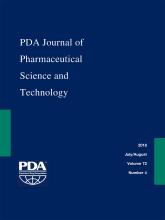Abstract
There has been a growing interest in recent years in the assessment of suitable vial/stopper combinations for storage and shipment of frozen drug products. Considering that the glass transition temperature (Tg) of butyl rubber stoppers used in container closure systems (CCSs) is between −55 °C to −65 °C, a storage or shipment temperature of a frozen product below the Tg of the rubber stopper may require special attention because below the Tg the rubber becomes more plastic like and loses its elastic (sealing) characteristics. Thus, they risk not maintaining container closure integrity (CCI). Given that the rubber regains its elastic properties and reseals after rewarming to ambient temperature, leaks during frozen temperature storage and transportation are transient and the CCI methods used at room temperature conditions are unable to confirm CCI in the frozen state. Hence, several experimental methods have been developed in recent years in order to evaluate CCI at low temperatures. Finite element (FE) simulations were applied in order to investigate the sealing behaviour of rubber stoppers for the drug product CCS under frozen storage conditions. FE analysis can help in reducing the experimental design space and thus the number of measurements needed, as they can be used as an add-on to experimental testing. Several scenarios have been simulated including the effect of thermal history, rubber type, storage time, worst-case CCS geometric tolerances, and capping pressure. The results of these calculations have been validated with experimental data derived from laboratory experiments (CCI at low temperatures), and a concept for tightness has been developed. It has been concluded that FE simulations have the potential to become a powerful predictive tool toward a better understanding of the influence of cold storage on the rubber sealing properties (and hence on CCI) when dealing with frozen drug products.
LAY ABSTRACT: The growing interest in the assessment of suitable vial/stopper combinations for storage and shipment of frozen drug products has led to the development of a number of experimental methods to evaluate container closure integrity at low temperatures. The application of finite element simulations could aid in the investigation of the sealing behaviour of rubber stoppers for drug product container closure systems under frozen storage conditions by simplifying the experimental design space and the number of experimental measurements needed. In this work several scenarios have been simulated including the effect of thermal history, rubber type, storage time, worst-case container closure system geometric tolerances, and capping pressure. The results have been further validated with experimental data derived from laboratory experiments and a concept for tightness was developed. In conclusion, finite element simulations have shown the potential to become a powerful predictive tool toward a better understanding of the influence of cold storage on the rubber sealing properties (and hence on container closure integrity) when dealing with frozen drug products.
- Container closure integrity
- Finite element analysis
- Frozen drug product
- Container closure system
- Vial
- Parenteral primary packaging
- © PDA, Inc. 2018
PDA members receive access to all articles published in the current year and previous volume year. Institutional subscribers received access to all content. Log in below to receive access to this article if you are either of these.
If you are neither or you are a PDA member trying to access an article outside of your membership license, then you must purchase access to this article (below). If you do not have a username or password for JPST, you will be required to create an account prior to purchasing.
Full issue PDFs are for PDA members only.
Note to pda.org users
The PDA and PDA bookstore websites (www.pda.org and www.pda.org/bookstore) are separate websites from the PDA JPST website. When you first join PDA, your initial UserID and Password are sent to HighWirePress to create your PDA JPST account. Subsequent UserrID and Password changes required at the PDA websites will not pass on to PDA JPST and vice versa. If you forget your PDA JPST UserID and/or Password, you can request help to retrieve UserID and reset Password below.






